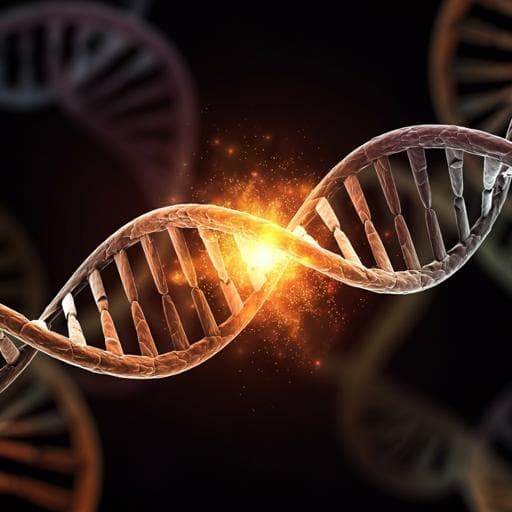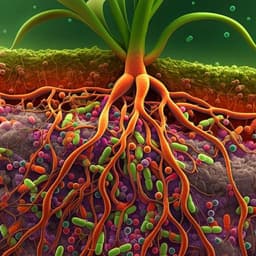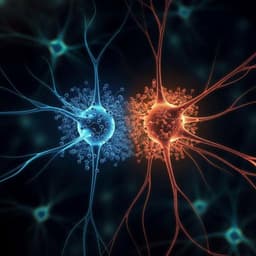
Medicine and Health
Failure of DNA double-strand break repair by tau mediates Alzheimer's disease pathology in vitro
M. Asada-utsugi, K. Uemura, et al.
This innovative study reveals the critical role of DNA double-strand breaks in Alzheimer's disease, particularly in the context of tau pathology. Conducted by a team of researchers including Megumi Asada-Utsugi and Kengo Uemura, the findings suggest that deficiencies in DSB repair contribute significantly to the progression of Alzheimer's, offering new insights into potential therapeutic targets.
~3 min • Beginner • English
Introduction
The study addresses whether DNA double-strand breaks (DSBs), which accumulate with age and are among the most severe forms of DNA damage, contribute to tau pathology in Alzheimer’s disease (AD). Given that microtubule-associated proteins polymerize to support DNA repair in dividing cells and tau is a key microtubule-associated protein, the authors hypothesize that DSBs recruit tau to facilitate repair in neurons and that failure of this process fosters pathological tau phosphorylation/aggregation and neurodegeneration. The work aims to define the spatial relationship between DSBs and tau pathology in human AD brain and to mechanistically test, in primary neurons, how DSBs affect tau localization, phosphorylation, interactions with tubulin, and toxicity.
Literature Review
Prior work shows DSBs increase with age and in neurodegenerative disease, including AD, and are linked to neuronal dysfunction. Cytoskeletal dynamics and microtubules contribute to genome maintenance, with DSBs promoting nuclear reorganization and DNA movement to nuclear pores or lamina to enable repair. Tau, beyond stabilizing microtubules, has been observed in the nucleus, binds DNA, and may protect DNA from oxidative damage; nuclear tau phosphorylation states are modulated by cellular pathways. Kinases activated by DNA damage, including CDK5, Chk1/Chk2, GSK3β, and p38 MAPK, can phosphorylate tau, potentially linking DNA damage responses to tauopathy. Neurons may engage cell cycle-related mechanisms to accomplish DSB repair, and microtubule-targeting agents can disrupt trafficking of DNA repair proteins, potentially exacerbating DNA damage. These observations motivated testing whether DSBs drive perinuclear recruitment and modification of tau, and whether microtubule disassembly impairs repair and promotes tau pathology.
Methodology
Human studies: Postmortem temporal lobe cortex, entorhinal cortex, hippocampus, and cerebral white matter sections from AD patients and controls were processed for immunohistochemistry and immunofluorescence. Double staining assessed neuronal and glial markers (MAP2, NeuN, GFAP, Iba1, ZO-1, Olig2) and DSB marker γH2AX; co-localization with phosphorylated tau (AT8) was examined.
Primary neuron studies: Primary mouse cortical neurons (ICR, embryonic day 14–16) were cultured in Neurobasal medium. DSBs were induced with etoposide (typically 50 μM) for 0–24 h, or with UV exposure (5–10 min) or bleomycin. Subcellular fractionation (NE-PER) yielded cytoplasmic and nuclear fractions for western blotting of tau species (total, non-phosphorylated Tau-1, phosphorylated AT8/AT180), γH2AX, histone H3, GAPDH, and caspase-3/cleaved caspase-3. DNA damage levels were quantified by alkaline comet assay (olive tail moment) across time points post-etoposide.
Immunocytochemistry and imaging: Confocal microscopy assessed subcellular distribution of Tau-1, AT8, and γH2AX, with 3D reconstructions and XZ/YZ projections to evaluate perinuclear accumulation and nuclear-associated signal. Immunogold electron microscopy localized Tau-1 and AT8 relative to nuclear membranes.
Protein-protein proximity: In situ proximity ligation assays (PLA) probed interactions between non-phosphorylated tau (Tau-1) and α-tubulin, and between tau species and nuclear components (LaminB, H3K9me3) following DSB induction. PLA for α/β-tubulin validated microtubule polymerization status and its inhibition.
Tau knockdown: Endogenous mouse tau was reduced in primary neurons via MISSION lentiviral shRNA (TRCN0000091300) versus non-targeting control. Knockdown efficacy was confirmed by western blot and immunocytochemistry. Neurons were challenged with etoposide (e.g., 50 μM, 30 min) and γH2AX levels compared between groups immediately and 24 h after recovery.
Microtubule disassembly experiments: Neurons were pretreated with 5HPP-33 (2.5 μM, 30 min), a microtubule polymerization inhibitor, followed by etoposide for 24 h. Outcomes included p-tau distribution (immunofluorescence), γH2AX and cleaved caspase-3 levels (soluble fraction), and total and phosphorylated tau accumulation in SDS-insoluble fractions (CBB-stained total protein reference). Parallel experiments used bleomycin to generalize DSB induction.
Statistics: Data are presented as mean ± SEM, analyzed with Student’s t test, one- or two-way ANOVA with Tukey/Tukey-Kramer post hoc tests; significance threshold P < 0.05. Sample sizes included numbers of images, cells (OpenComet analysis), or independent experiments as indicated in figure legends.
Key Findings
- Human brain: γH2AX was elevated in AD cortex and entorhinal cortex neurons and often co-localized with neuronal markers (MAP2, NeuN), with fewer γH2AX-positive neurons in hippocampus. Quantification: hippocampus γH2AX increased in AD (p = 0.0027); cortex/entorhinal cortex γH2AX in MAP2-positive neurons increased (p = 0.0177); white matter showed no significant difference (p = 0.4619). AT8-positive cortical cells occasionally exhibited DSBs; co-localization in hippocampus was rare.
- DSB kinetics and tau fractionation in primary neurons: Etoposide (50 μM) induced peak γH2AX at 3 h by western blot (one-way ANOVA P = 0.0485, n = 5) and maximal DNA damage by comet assay at 3 h; active caspase-3 appeared at 6–24 h. In cytoplasm, p-tau (AT8) increased at 6–24 h; non-p-tau (Tau-1) peaked at 6 h then declined by 24 h. In nuclear fractions, both non-p-tau and p-tau increased at 6 h. UV (5–10 min) increased total, non-phosphorylated, and phosphorylated tau rapidly.
- Perinuclear recruitment: At 6 h after etoposide, non-p-tau (Tau-1) intensified around the nucleus (confocal XZ/3D) and within DAPI regions, with increased Tau-1 intensity in DAPI area (p = 0.0041). PLA showed increased proximity between Tau-1 and LaminB or H3K9me3 after DSBs, and immunogold EM localized Tau-1 near the nuclear membrane.
- Phosphorylated tau localization and toxicity: At 24 h, AT8 intensity increased in nuclear/DAPI areas (p = 0.0168) and redistributed closer to nuclear membranes by EM. Oligomeric toxic tau (T22) increased dose-dependently with DSB induction.
- Tau-tubulin interaction: PLA revealed a marked rise in Tau-1–α-tubulin proximity after etoposide, peaking at 6 h; PLA foci per DAPI increased significantly (0 h vs 6 h, p = 0.0005; 0.5 h vs 6 h, p = 0.011; 24 h vs 6 h, p = 0.015). PLA for p-tau with tubulin was minimal, indicating preferential interaction of non-p-tau with tubulin during DSB response.
- Tau knockdown effects: shRNA reduced tau protein by ~60% and, after 30 min etoposide, increased γH2AX approximately 2-fold relative to control (p = 0.0367) without altering active caspase-3, suggesting endogenous tau supports early DSB repair. After a 24 h recovery post-30 min DSB, tau knockdown reduced γH2AX by ~60% versus control, consistent across shRNA clones, indicating complex temporal roles of tau in damage signaling/repair.
- Synergy with microtubule disassembly: Combined DSB (etoposide or bleomycin) and microtubule polymerization inhibition (5HPP-33) caused widespread cytosolic p-tau accumulation resembling neurofibrillary tangles, elevated γH2AX (soluble fraction; n = 7, p < 0.0001), increased cleaved caspase-3 (e.g., DMSO vs ETO p = 0.0176; ETO vs 5HPP+ETO p = 0.0496; DMSO vs 5HPP+ETO p = 0.0004), and increased insoluble p-tau (AT8) (n = 4; p = 0.0425–0.0005). These data link failed microtubule assembly during DSB response to tau aggregation and apoptosis.
Discussion
Findings support a model where DSBs recruit non-phosphorylated tau to the perinuclear region, in conjunction with augmented interaction with tubulin and microtubule assembly, potentially to facilitate DNA repair via nuclear-cytoskeletal coupling. Subsequently, tau becomes phosphorylated, accumulates around the nuclear membrane, and oligomerizes, associating with toxicity. Human AD brain data show increased neuronal DSBs in cortex/entorhinal regions and occasional co-localization with p-tau, consistent with pathological tau emerging in DSB-rich contexts. Tau knockdown enhances early γH2AX signaling after DSB induction, indicating that tau contributes to early repair processes. However, when microtubule polymerization is pharmacologically impaired during DSBs, neurons exhibit NFT-like p-tau aggregation, higher DNA damage signaling, and apoptosis, implicating cytoskeletal failure as a driver of tauopathy and neuronal death. The discussion situates results within broader literature on nuclear tau, DNA damage kinases (CDK5, Chk1/Chk2, GSK3β, p38 MAPK) that can phosphorylate tau during DNA damage responses, and the possibility of neuron cell-cycle re-entry aiding repair. Differences in DSB patterns between neurons and glia in AD tissue may reflect cell-type-specific repair capacity and survival. Overall, the work links DSB repair failure to tau pathology and neurodegeneration, emphasizing the importance of intact microtubule dynamics in the neuronal DNA damage response.
Conclusion
The study demonstrates that DSBs promote perinuclear accumulation of non-phosphorylated tau and its interaction with tubulin, followed by phosphorylated tau accumulation and oligomerization associated with neurotoxicity. In human AD cortex and entorhinal cortex, DSBs are elevated and can co-occur with p-tau. Endogenous tau appears to support early DSB repair, whereas disruption of microtubule polymerization during DSBs drives pathological p-tau aggregation and apoptosis. These findings propose a mechanistic link between impaired DSB repair and tauopathy in AD. Future research should delineate the molecular mechanisms by which non-p-tau supports DNA repair, define how DNA damage-activated kinases regulate tau modifications in this context, and test interventions that preserve microtubule dynamics and DNA repair to mitigate tau pathology and neurodegeneration.
Limitations
The molecular basis by which non-phosphorylated tau facilitates DNA repair was not elucidated. Human tissue analyses were limited in scope and cell-type interpretations may be confounded by neuronal loss in AD, potentially underestimating neuronal DSBs while highlighting glial signals. Most mechanistic experiments used in vitro primary neuron models and acute DSB inducers, which may not fully recapitulate chronic in vivo conditions. Phospho-tau analyses focused on select epitopes (e.g., AT8), and site-specific differences might yield distinct nuclear dynamics.
Related Publications
Explore these studies to deepen your understanding of the subject.







